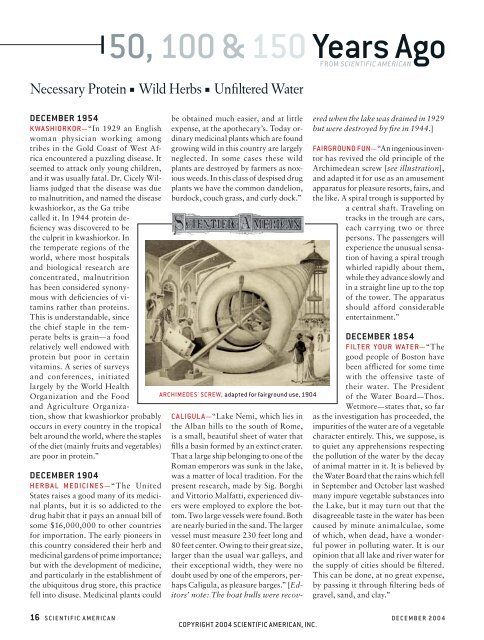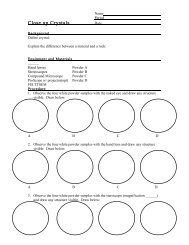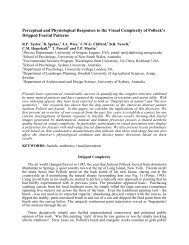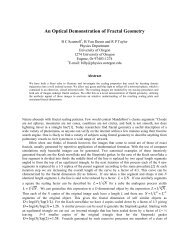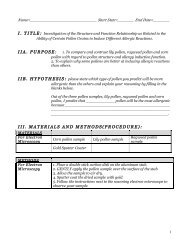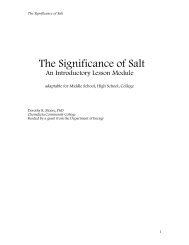December 2004 - Materials Science Institute - University of Oregon
December 2004 - Materials Science Institute - University of Oregon
December 2004 - Materials Science Institute - University of Oregon
You also want an ePaper? Increase the reach of your titles
YUMPU automatically turns print PDFs into web optimized ePapers that Google loves.
DECEMBER 1954<br />
KWASHIORKOR—“In 1929 an English<br />
woman physician working among<br />
tribes in the Gold Coast <strong>of</strong> West Africa<br />
encountered a puzzling disease. It<br />
seemed to attack only young children,<br />
and it was usually fatal. Dr. Cicely Williams<br />
judged that the disease was due<br />
to malnutrition, and named the disease<br />
kwashiorkor, as the Ga tribe<br />
called it. In 1944 protein defi<br />
ciency was discovered to be<br />
the culprit in kwashiorkor. In<br />
the temperate regions <strong>of</strong> the<br />
world, where most hospitals<br />
and biological research are<br />
concentrated, malnutrition<br />
has been considered synonymous<br />
with defi ciencies <strong>of</strong> vitamins<br />
rather than proteins.<br />
This is understandable, since<br />
the chief staple in the temperate<br />
belts is grain—a food<br />
relatively well endowed with<br />
protein but poor in certain<br />
vitamins. A series <strong>of</strong> surveys<br />
and conferences, initiated<br />
largely by the World Health<br />
Organization and the Food<br />
and Agriculture Organization,<br />
show that kwashiorkor probably<br />
occurs in every country in the tropical<br />
belt around the world, where the staples<br />
<strong>of</strong> the diet (mainly fruits and vegetables)<br />
are poor in protein.”<br />
DECEMBER 1904<br />
HERBAL MEDICINES—“The United<br />
States raises a good many <strong>of</strong> its medicinal<br />
plants, but it is so addicted to the<br />
drug habit that it pays an annual bill <strong>of</strong><br />
some $16,000,000 to other countries<br />
for importation. The early pioneers in<br />
this country considered their herb and<br />
medicinal gardens <strong>of</strong> prime importance;<br />
but with the development <strong>of</strong> medicine,<br />
and particularly in the establishment <strong>of</strong><br />
the ubiquitous drug store, this practice<br />
fell into disuse. Medicinal plants could<br />
50, 100 & 150 Years Ago<br />
FROM SCIENTIFIC AMERICAN<br />
Necessary Protein ■ Wild Herbs ■ Unfi ltered Water<br />
be obtained much easier, and at little<br />
expense, at the apothecary’s. Today ordinary<br />
medicinal plants which are found<br />
growing wild in this country are largely<br />
neglected. In some cases these wild<br />
plants are destroyed by farmers as noxious<br />
weeds. In this class <strong>of</strong> despised drug<br />
plants we have the common dandelion,<br />
burdock, couch grass, and curly dock.”<br />
ARCHIMEDES' SCREW, adapted for fairground use, 1904<br />
CALIGULA—“Lake Nemi, which lies in<br />
the Alban hills to the south <strong>of</strong> Rome,<br />
is a small, beautiful sheet <strong>of</strong> water that<br />
fi lls a basin formed by an extinct crater.<br />
That a large ship belonging to one <strong>of</strong> the<br />
Roman emperors was sunk in the lake,<br />
was a matter <strong>of</strong> local tradition. For the<br />
present research, made by Sig. Borghi<br />
and Vittorio Malfatti, experienced divers<br />
were employed to explore the bottom.<br />
Two large vessels were found. Both<br />
are nearly buried in the sand. The larger<br />
vessel must measure 230 feet long and<br />
80 feet center. Owing to their great size,<br />
larger than the usual war galleys, and<br />
their exceptional width, they were no<br />
doubt used by one <strong>of</strong> the emperors, perhaps<br />
Caligula, as pleasure barges.” [Editors’<br />
note: The boat hulls were recov-<br />
ered when the lake was drained in 1929<br />
but were destroyed by fi re in 1944.]<br />
FAIRGROUND FUN—“An ingenious inventor<br />
has revived the old principle <strong>of</strong> the<br />
Archimedean screw [see illustration],<br />
and adapted it for use as an amusement<br />
apparatus for pleasure resorts, fairs, and<br />
the like. A spiral trough is supported by<br />
a central shaft. Traveling on<br />
tracks in the trough are cars,<br />
each carrying two or three<br />
persons. The passengers will<br />
experience the unusual sensation<br />
<strong>of</strong> having a spiral trough<br />
whirled rapidly about them,<br />
while they advance slowly and<br />
in a straight line up to the top<br />
<strong>of</strong> the tower. The apparatus<br />
should afford considerable<br />
entertainment.”<br />
DECEMBER 1854<br />
FILTER YOUR WATER—“The<br />
good people <strong>of</strong> Boston have<br />
been affl icted for some time<br />
with the <strong>of</strong>fensive taste <strong>of</strong><br />
their water. The President<br />
<strong>of</strong> the Water Board—Thos.<br />
Wetmore—states that, so far<br />
as the investigation has proceeded, the<br />
impurities <strong>of</strong> the water are <strong>of</strong> a vegetable<br />
character entirely. This, we suppose, is<br />
to quiet any apprehensions respecting<br />
the pollution <strong>of</strong> the water by the decay<br />
<strong>of</strong> animal matter in it. It is believed by<br />
the Water Board that the rains which fell<br />
in September and October last washed<br />
many impure vegetable substances into<br />
the Lake, but it may turn out that the<br />
disagreeable taste in the water has been<br />
caused by minute animalculae, some<br />
<strong>of</strong> which, when dead, have a wonderful<br />
power in polluting water. It is our<br />
opinion that all lake and river water for<br />
the supply <strong>of</strong> cities should be fi ltered.<br />
This can be done, at no great expense,<br />
by passing it through fi ltering beds <strong>of</strong><br />
gravel, sand, and clay.”<br />
16 SCIENTIFIC AMERICAN DECEMBER <strong>2004</strong><br />
COPYRIGHT <strong>2004</strong> SCIENTIFIC AMERICAN, INC.


